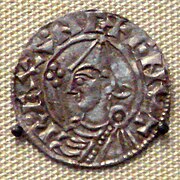House of Denmark
| House of Knýtlinga | |
|---|---|
 |
|
| Country | Kingdom of Denmark, Kingdom of Norway, Kingdom of Sweden, Kingdom of England |
| Titles | |
| Founder | Gorm the Old |
| Cadet branches | House of Estridsen (female line) |
The Danish House of Knýtlinga (English: "House of Cnut's Descendants") was a ruling royal house in Middle Age Scandinavia and England. Its most famous king was Cnut the Great, who gave his name to this dynasty. Other notable members were Cnut's father Sweyn Forkbeard, grandfather Harald Bluetooth, and sons Harthacnut, Harold Harefoot, and Svein Knutsson. It has also been called the House of Canute, the House of Denmark, the House of Gorm, or the Jelling Dynasty.
In 1018 AD the House of Knýtlinga brought the crowns of Denmark and England together under a personal union. At the height of its power, in the years 1028–1030, the House reigned over Denmark, England and Norway. After the death of Cnut the Great's heirs within a decade of his own death and the Norman conquest of England in 1066, the legacy of the Knýtlinga was largely lost to history.
The House of Knýtlinga ruled the Kingdom of England from 1013 to 1014 and from 1016 to 1042.
In 1013 Sweyn Forkbeard, already the king of Denmark and of Norway, overthrew King Æthelred the Unready of the House of Wessex. Sweyn had first invaded England in 1003 to avenge the death of his sister Gunhilde and many other Danes in the St. Brice's Day massacre, which had been ordered by Æthelred in 1002.
...
Wikipedia
